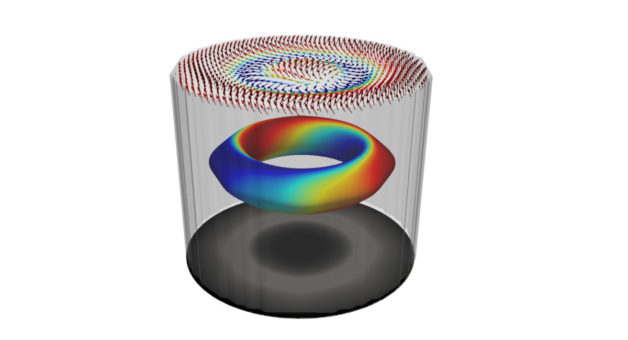This has been adapted from a Berkeley Lab press release.

A decade ago, the discovery of quasiparticles called magnetic skyrmions provided important new clues into how microscopic spin textures will enable spintronics, a new class of electronics that use the orientation of an electron’s spin rather than its charge to encode data.
But although scientists have made big advances in this very young field, they still don’t fully understand how to design spintronics materials that would allow for ultrasmall, ultrafast, low-power devices. Skyrmions may seem promising, but scientists have long treated skyrmions as merely 2D objects. Recent studies, however, have suggested that 2D skyrmions could actually be the genesis of a 3D spin pattern called hopfions. But no one had been able to experimentally prove that magnetic hopfions exist on the nanoscale.
Now, a team of researchers co-led by Berkeley Lab has reported in Nature Communications the first demonstration and observation of 3D hopfions emerging from skyrmions at the nanoscale (billionths of a meter) in a magnetic system. The researchers say that their discovery heralds a major step forward in realizing high-density, high-speed, low-power, yet ultrastable magnetic memory devices that exploit the intrinsic power of electron spin.
“We not only proved that complex spin textures like 3D hopfions exist – We also demonstrated how to study and therefore harness them,” said co-senior author Peter Fischer, a senior scientist in Berkeley Lab’s Materials Sciences Division. “To understand how hopfions really work, we have to know how to make them and study them. This work was possible only because we have these amazing tools at Berkeley Lab and our collaborative partnerships with scientists around the world,” he said.
According to previous studies, hopfions, unlike skyrmions, don’t drift when they move along a device and are therefore excellent candidates for data technologies. Furthermore, theory collaborators in the United Kingdom had predicted that hopfions could emerge from a multilayered 2D magnetic system.
The current study is the first to put those theories to test, Fischer said.
Using nanofabrication tools at the Molecular Foundry, the team worked with Foundry staff to carve out magnetic nanopillars from layers of iridium, cobalt, and platinum.
Read the full press release.

